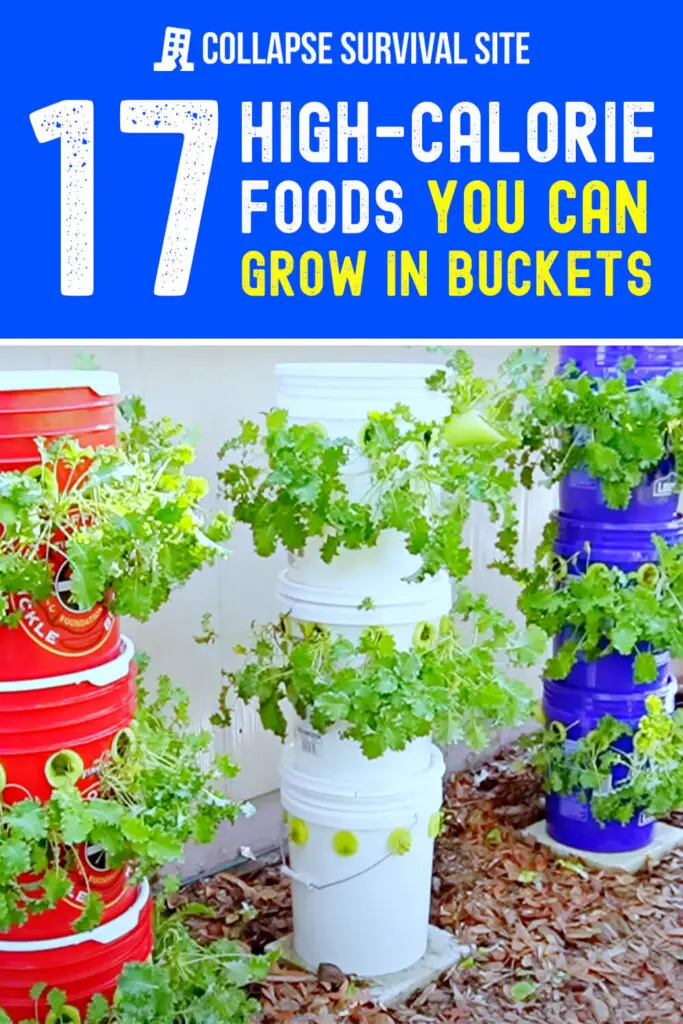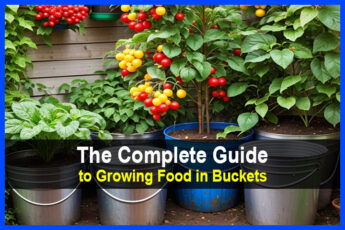Estimated reading time: 6 minutes
As climate change takes center stage and grocery bills skyrocket, green thumbs are emerging everywhere. But urban dwellers and those with limited space might be scratching their heads, wondering how they can dig in.
Here’s a solution that's both innovative and space-savvy: bucket gardening. And not just any crops – we're talking about power-packed, high-calorie ones.
Why Buckets?
- Weatherproof: Rainstorm? Heatwave? Easy-peasy. Simply move your bucket garden indoors.
- Weed-free zone: Say goodbye to those pesky invaders.
- Minimized Pests: Reduced need for pesticides. Hurray for organic!
- Soil Control: Be the maestro of your soil composition, making your crops dance to your tunes.
Convinced yet? Great! Let’s dive into a list of high-calorie, bucket-friendly superstars:
Want to save this article for later? Click Here to Pin It On Pinterest!
1. Amaranth
A staple in many ancient cultures, amaranth offers vibrant flowers and edible grains. The leaves, often used in salads or as a spinach substitute, are rich in vitamins. Amaranth thrives in full sunlight, needing at least 6-8 hours daily. The soil should be well-drained and consistently moist.
Tip: Rotate the bucket occasionally for even growth and exposure to sunlight.
2. Avocadoes
A delicious fruit rich in healthy fats, avocadoes come in various varieties, from the creamy Hass to the watery Fuerte. Though they take time to bear fruit, the wait is incredibly rewarding. Ideal for large containers, dwarf varieties are best for bucket gardening. These need full sunlight and well-draining soil.
Tip: Avocado trees benefit from occasional fertilizing, so consider adding compost or a balanced fertilizer for better growth.
3. Beans
Beans, be it green, kidney, or pinto, are rich in protein and fiber, making them a great meat substitute. They grow quickly and can be harvested multiple times throughout their growing season. Beans need full sunlight and evenly moist soil.
Tip: Adding an organic mulch on top can help maintain soil moisture and keep the beans healthy.
4. Beets
Beets, with their deep red hue, are as nutritious as they are beautiful. Both the root and the leaves are edible, offering a double bounty. They adapt well to containers and need consistent moisture.
Tip: Beets can benefit from occasional feeding, so consider a light application of a balanced fertilizer as they grow.
5. Butternut Squash
This winter squash offers sweet, nutty flesh that's perfect for soups and roasts. As a vine, it sprawls but can be trained to grow in confined spaces. Butternut squash requires direct sunlight and well-drained soil.
Tip: Train the vines upward to save space and get better air circulation.
6. Carrots
Crunchy and sweet, carrots come in various colors, from traditional orange to purple, red, and even white. These root vegetables are rich in vitamins and minerals, especially beta-carotene. Consistent moisture without waterlogging is key.
Tip: Using sand-mixed soil can help in the smooth growth of the carrot root.
7. Corn
Sweet corn, when fresh, is a delightful treat. It can be grilled, boiled, or even eaten raw. Corn plants are impressive, with their tall stalks and silky tassels. They require full sunlight and consistent moisture.
Tip: Plant multiple corn plants together to ensure better pollination and kernel formation.
8. Hazelnuts
Hazelnuts, also known as filberts, are a rich source of calories, fats, and protein. A staple in European diets, these nuts have a sweet taste that complements both savory dishes and desserts, such as the ever-popular chocolate-hazelnut spread.
Growing hazelnuts in buckets can be a space-saving venture, especially when selecting dwarf varieties suitable for container gardening. They require well-draining soil and appreciate full sunlight, though they can tolerate some shade.
Tip: Ensure cross-pollination by planting two or more compatible hazelnut varieties close to each other, as this will significantly increase nut yield.
9. Jerusalem Artichokes
Also known as sun chokes, these tubers offer a nutty, sweet flavor, somewhat akin to a water chestnut. They're versatile in the kitchen and are a great source of inulin. Jerusalem artichokes need full sunlight and well-drained soil.
Tip: These plants can grow tall; consider staking them.
10. Lentils
A vital protein source in vegetarian diets, lentils are versatile in the kitchen, finding their way into soups, stews, and salads. They're drought-tolerant and relatively easy to grow. Lentils thrive in full sunlight and well-drained soil.
Tip: Harvesting them early gives you green lentils; maturing gives dried lentils.
11. Melons
From cantaloupes to watermelons, these fruits are summer favorites. They're sweet, juicy, and refreshing on a hot day. Compact or bush varieties are ideal for buckets, needing full sunlight.
Tip: Provide a net or sling to support the growing melons.
12. Parsnips
These root vegetables, resembling white carrots, have a sweet, nutty flavor that intensifies with cold exposure. They're great roasted, mashed, or even raw in salads. Parsnips grow well in buckets with full sunlight.
Tip: Cold temperatures enhance their sweetness, so consider leaving them in soil after the first frost.
13. Peas
Peas, whether snap, snow, or garden, are delicious fresh from the pod or cooked. They're an early spring crop, often one of the first to be planted. Peas need full sunlight and well-drained soil.
Tip: Regularly pick mature pods to encourage more production.
14. Potatoes
A staple in many diets, potatoes are versatile and nutritious. They're underground tubers that grow in response to the plant's flowering. Compact or early-maturing varieties are best for bucket gardening.
Tip: Hilling or adding soil as the plant grows ensures emerging tubers remain covered.
15. Strawberries
These berries are a treat straight from the garden, offering sweetness and juiciness. They can produce fruit either in their first or second year, depending on the variety. Strawberries need full sunlight and consistent moisture.
Tip: Protect your crop with netting to deter birds and slugs.
16. Sweet Potatoes
Distantly related to common potatoes, sweet potatoes offer orange, sweet flesh that's rich in vitamins. They have a sprawling habit but can be grown in confined spaces. They need full sunlight, well-drained soil, and consistent moisture.
Tip: Vine cuttings or “slips” are the best way to propagate them in buckets.
17. Yams
Often confused with sweet potatoes, yams are starchy tubers native to Africa and Asia. They have rough, dark skin with off-white, purple, or red flesh. Yams need full sunlight and consistent moisture.
Tip: Ensure your bucket is deep enough to accommodate their growth.
Pro Tips for Successful Bucket Gardening:
- Limited Sunlight? No Problem! Invest in grow lights. Solar-powered ones can be a boon in areas with unstable electricity.
- Water Woes? Collect and recycle. Use drained out water or adopt reservoir watering to keep those roots perfectly moist.
- Community Spirit: As you master the art, share the knowledge. Empower your community with the gift of self-reliance.
Bucket gardening isn't just a fun hobby; it's a stride towards self-sufficiency. It's more than just planting a seed; it’s planting hope and resilience in a fast-changing world. As we sail into uncharted territories, let’s carry with us the tools of adaptability, community, and, of course, our trusty buckets.
Like this post? Don't Forget to Pin It On Pinterest!








